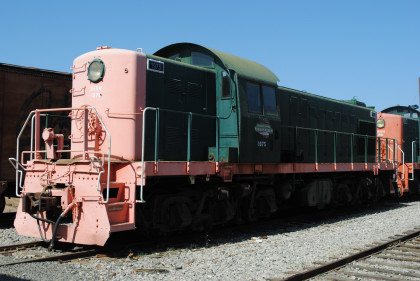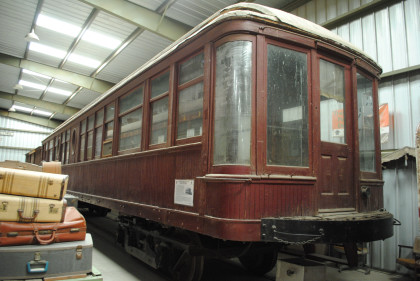The day started with a Pacific Surfliner trip from Los Angeles to Santa Ana, where Chris and a friend of his, Adam, were waiting for us. We set off for Perris and soon immersed ourselves in everything that the museum had to offer.
Note - although the museum changed its name to the Southern California Railway Museum, I have chosen to keep the name by which it is most well-known, not just because it was the Orange Empire Railway Museum in 2012. The same goes for places that have been re-named (such as Sears Tower to Willis Tower); the traditional and former name is how I will always refer to them.
Orange Empire Railway Museum HistoryThe museum was founded in 1956 at Griffith Park in Los Angeles, before moving to the former Pinacate Station as the Orange Empire Trolley Museum in 1958. It was renamed Orange Empire Railway Museum in 1975 after merging with a museum then known as the California Southern Railroad Museum. The museum also operates a heritage railroad on the museum grounds. The collection focuses on Southern California's railroad history. It houses the largest collection of Pacific Electric Railway rolling stock in the world, much of it rescued from scrapyards after the discontinuation of their passenger operations. Two early Los Angeles narrow gauge streetcars from the Los Angeles Railway or standard gauge streetcars from the Pacific Electric Railway run each weekend on the half mile, dual gauge Loop Line. A passenger-carrying steam, diesel or electric powered freight train with open gondolas fitted with benches and at least two cabooses runs on the 1.5 mile standard gauge mainline that was once a part of the transcontinental main line of the Atchison, Topeka and Santa Fe Railway (to San Diego). Its main line stretches from south of the museum northward towards the junction with the BNSF Railway, where the historic Perris Depot on State Route 74 stands. The BNSF Railway spur is in active use, but the museum track onto the spur is currently severed due to Metrolink service, meaning that no museum trains can access the Perris Depot. A Pacific Electric Red Car also operates on the mainline on selected weekends, but the line electrification ends a block south of the depot. Streetcars and locomotives are selected on a rotating basis.
The welcome sign. The four of us walked around the grounds first before riding the trains and exploring the car barns.
Santa Fe caboose 1761 built 1929.
Southern Pacific bay window caboose 374.
United States Air Force 80 ton switcher 1601 which worked at Tinker Air Force Base in Oklahoma.
United States Air Force 45 ton switcher 7441, originally at March Air Force Base.
United States Navy V0-1000 switcher 8 (ex. Port of Los Angeles Authority 1. exx. US Navy 8, nee US Navy 2 1944).
Hutcinson and Northern steeple-cab switcher 1.
Railway crossbucks and a wig-wag signal in this crossing scene.
Santa Fe baggage car 2602, built 1923.
Santa Fe FP45 98 (ex. BNSF 98, exx. ATSF 5998, exxx. ATSF 102, exxxx. ATSF 5998, exxxxx. ATSF 5948, nee ATSF 108). This was the last FP45 bought by the railway and was the first of two to be re-painted in Superfleet red and silver livery in 1989.
The front of this locomotive which was being worked on.
Orange Empire Railway Museum RSD-1 1956 (ex. US Army 8009, nee Department of Transporation 012).
The museum emblem and number on the RSD-1.

Orange Empire Railway Museum RSD-1 1975 (ex. US Army 8018, nee Department of Transporation 015).
The emblem on this engine.
Southern California Edison ML-6 switcher 12 (nee United States Army) built 1941 and donated to the museum in 1974.
Santa Fe wrecking derrick 199774.
Southern Pacific maintenance-of-way wrecking derrick MW7090 (ex. Southern Pacific MW-7024, nee Central Pacific 615 1912).
Kerr-McGee S-12 845 (nee Southern Pacific 1550 1953).
Kerr-McGee S-12 844 (nee Southern Pacific 1543 1953).
Mojave Northern 0-6-0T 2 built 1917. In 1966, it was donated by Southwest Portland Cement to the California Southern Railroad Museum. The CRSM leased the right-of- way through Perris and the two organisations worked side-by-side until they amalgamated in 1975 to form the Orange Empire Museum.
Union Pacific chair car 542 (nee Los Angeles and Salt Lake 4140.)
O'Neill's Streamlined Diner built in the 1930's fashioned from a 1906 Santa Fe coach. It provided meals along Highway 395, six miles north of Perris.
It was then that Los Angeles Railway PCC car 3001 came by and returned to the station to board.
History and information on PCC car 3001, which was unveiled by Shirley Temple in 1937.
Explanation of a PCC car.
Los Angeles Railway Streetcar 1201 rounds the curve to the station. It was built in 1921 and retired in 1955. After being displayed in the City of Inglewood, it moved to Travel Town in Los Angeles and then to OERM. Bob had had some experience being a motorman several years earlier at another museum and asked if he could operate 1201. After a brief training, he ran the car under supervision and was able to lower and raise the trolley pole on the first attempt.
History of streetcar 1201.
Interior view.
At the station.
Los Angeles Railway 1201 on its way around the museum site. Once our ride was finished, we entered the Car Barn 1 and found lots of treasures.
Los Angeles Metropolitan Transit Authority PCC car 3165 built 1948. It was the last streetcar acquired for operation in the city.
Los Angeles Railways streetcar 665, built 1911 and retired in 1948.
Details about the funeral car "Descanso".
Los Angeles Railway trolley funeral car "Descanso" (Spanish for rest). It was built in 1909 as funeral car "Paraiso (paradise). The funeral service ended in 1924
and the car was sold to Railroad Boosters who moved it to the summit of Cajon Pass, using it as a clubhouse until 1967 when it was donated to OERM.
Two more views of this unique car.
Los Angeles Transit Lines streetcar 1160 built in 1923. Acquired in 1953, it was the first car purchased by the museum.
History of streetcar 1160.
Los Angeles Railway PCC car 3100 built in 1943 and retired twenty years later.
Not only is equipment stored in Carbarn 1; Los Angeles Railway memorabelia is also on display.
California Street Cable Railway car 43, built in 1906 and operated in San Francisco until the mid 1950's when it was sold to Knott's Berry Farm where it remained until 1979.
Engine House 6 houses Ward Kimball's Grizzly Flats Ralroad. The Grizzly Flats began in Ward and Betty Kimball's San Gabriel back garden. Ward, who was then an animator for Walt Disney Studios and avid railroad enthusiast, decided to buy the last passenger coach from Southern Pacific's narrow gauge subsidiary, the Carson & Colorado Railroad
.Grizzy Flats Railroad history.
Grizzly Flats Railroad 0-4-2T "Chloe" (nee Waimanolo Sugar Company 2 "Pokaa" 1883).
The cab area of "Chloe", named after Ward Kimball's daughter.
History of "Chloe"
Grizzly Flats Railroad four-bench open air coach.
Grizzly Flats 2-6-0 2 "Emma Nevada" (ex. Union Pacific 2 "Sidney Dillon", nee Nevada Central 2 1881). It was retired in 1938 when purchased by Ward Kimball. Emma Nevada was a famous opera star of the late 1800's.
We returned outside to find Union Pacific 2-8-2 2564 (ex. Oregon Short Line 2564 1923, exx. Los Angeles and Salt Lake 2725 1922, nee Los Angeles and Salt Lake 3725 1921) and acquired by OERM in 1996. When in LA&SL service, it operated on the east end of the line between Salt Lake City, Utah and Caliente, Nevada.
A gallows turntable.
The view through the turntable.
Los Angeles Railway PCC car 3001 made its rounds again and we boarded for the second ride of the day.
Two OERM volunteers using the handcar. This looked like fun. It was then time to ride the excursion train.
The Pinacate station, housing the ticket and information office and gift shop as seen from the platform.
A view down the tracks while waiting for our train.
Santa Fe FP45 98 and the train are being prepared for the first run of the day.
Southern Pacific coaches 2144 and 2350 with cabooses made up the consist.
SOuthern Pacific coach 2144, built as a commuter coach in 1923.
Delaware, Lackawanna and Western coach 2350 (nee 698 1920). Lettered for Southern Pacific from use in a film.
Union Pacific caboose 25129 and Santa Fe caboose 999020 as the rear of the train.
Union Pacific caboose 25129 which myself, Bob, Chris and Adam rode in.
My first time riding in a caboose.
Chris ready to photographically document the trip from his perch in the cupola.
Views along the route from my vantage point on the right side of the train. Upon our return, we made our way to Carbarn 2.
The Pacific Electric logo on Carbarn 2 here at Orange Empire Railway Museum.
Pacific Electric Hollywood car 655 (nee PE 5094), built 1954.
Pacific Electric Hollywood car 717 built in 1922.
Pacific Electric Birney car 331 built in 1918.
Yakima Valley Transportation electric locomotive 297, built 1923.
Pacific Electric multiple unit coach 1001 built in 1913.
San Francisco Municipal Railway streetcar 171 built in 1923.
Pacific Electric streetcar 332 painted in Old Pueblo Trolley livery. Built 1918.
The interior of PE 332.
We hurried outside as we heard the streetcar on its route and found Bob was running 1201. Photo by Chris Guenzler.
I had read about the refurbishment and restoration of Union Pacific E8A 942 that had been finished a month before our visit and was eager to see it in person, especially as I am partial to E and F units. 942 was sold to OERM in 1997 and its history is ex. Pacific Rail Industries 842 1991, exx. Kasten Railcar Services 842 1989, exxx. Chicago and North Western 510 1972, exxxx. Precision National Corporation 842 1972, nee Union Pacific 842 1953.
SOO Line business car 54 "Mount Rubidoux" (ex. private owner, exx. SOO business cr 54, nee SOO buffet-lounge 1704 1917).
Pacific Electric blimp multiple unit coach 418 built in 1913.
Ventura County 2-6-2 2 (nee Cascade Timber Company 107 1922). It arrived in Perris in 1973 and led excursion trains before being rebuilt and returned to steam in 2006.

Pacific Electric Officers Car 1000 built in 1913.
The Pacific Electric logo on the side of 1000.
San Diego Electric Railway 508, built 1936.
Ireland's Hill of Howth Tramway double-deck car 2, built 1901 and purchased by the museum in 1959.
History and details about Hill of Howth Tramway 2. This brought an end to our visit but we had one more place to stop before leaving Perris.
The (as of 2012) non-operational Metrolink station.
The City of Perris logo on the shelter. We stopped by Riverside Live Steamers but there was a long line so we did not wait. On the way back to Santa Ana, we stopped at The Habit for a late lunch then Bob and I took the train back to Los Angeles. We had no plans that evening and as Bob wanted to rest, I called the Ahmanson Theatre ticket office to see if there were any tickets available for the evening performance of Stephen Sondheim's musical "Follies", which we had seen the previous evening. There were and I chose a seat two rows closer! So I took the Red Line to Civic Centre and saw the show for a second night running, something I had never done before, or since. It was as excellent as it had been the night before and to top it off, Elaine Paige exited the theatre through the stage door and I was able to meet her and get her autograph. Talk about the perfect ending to a fabulous day!
| RETURN TO THE MAIN PAGE |